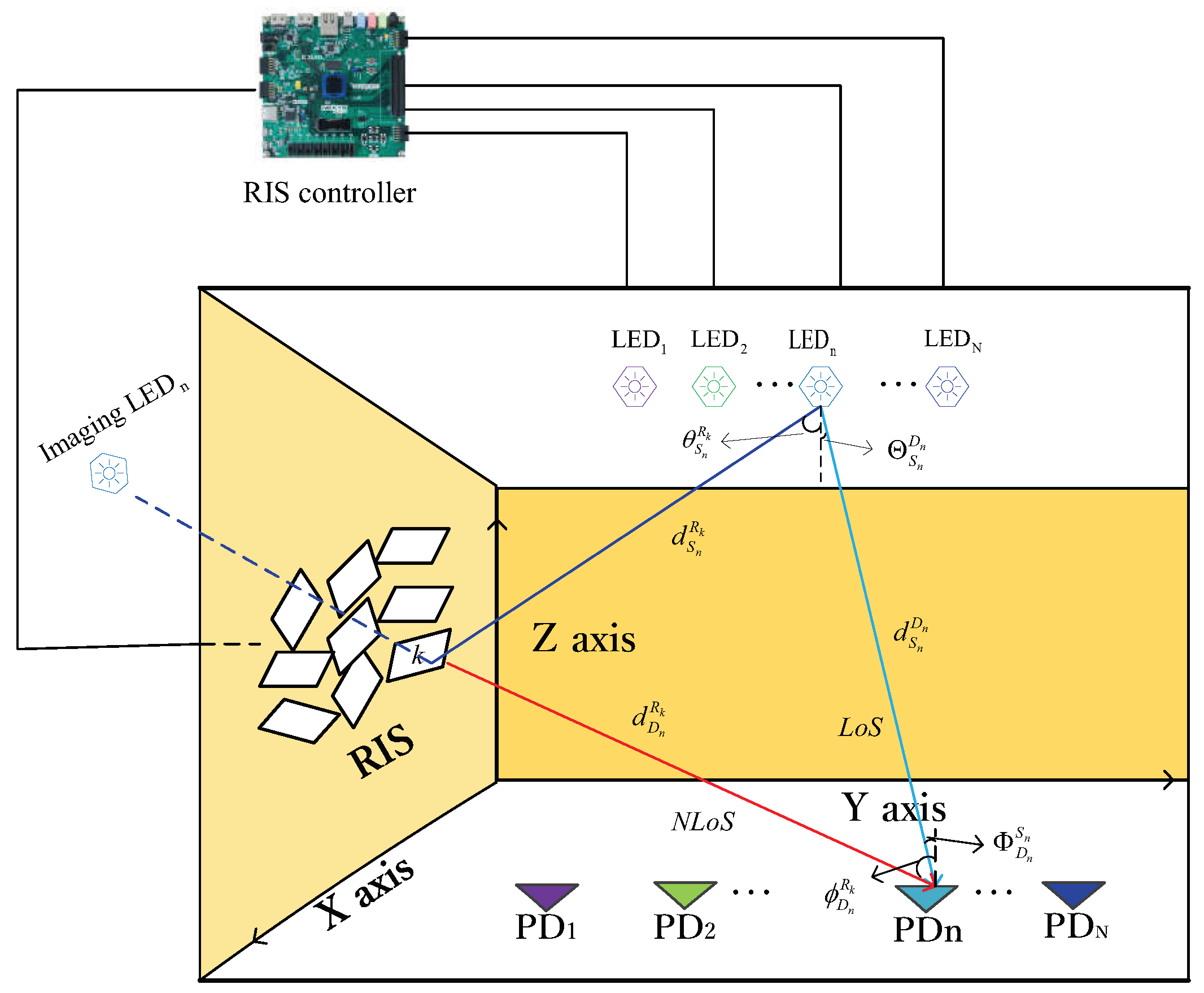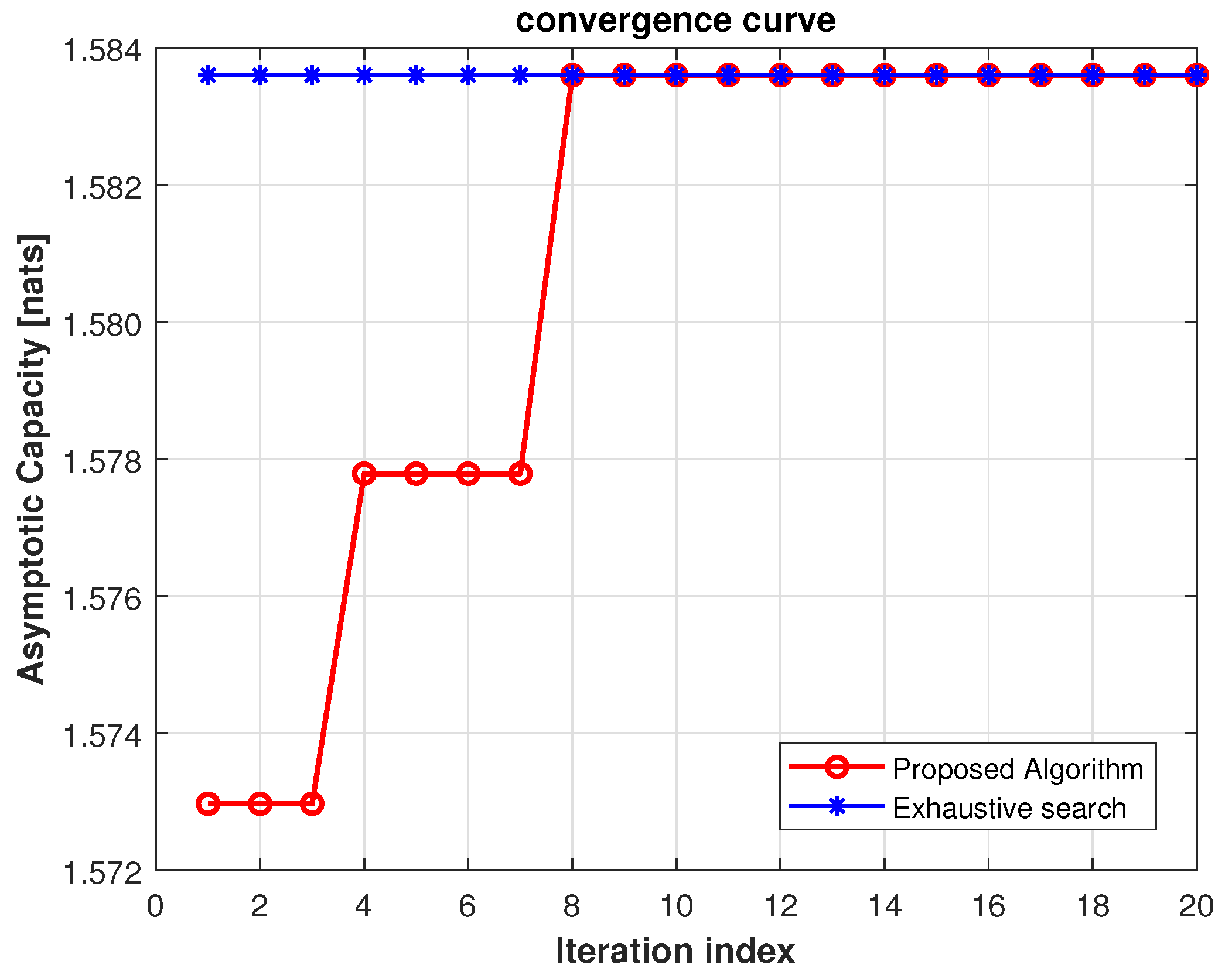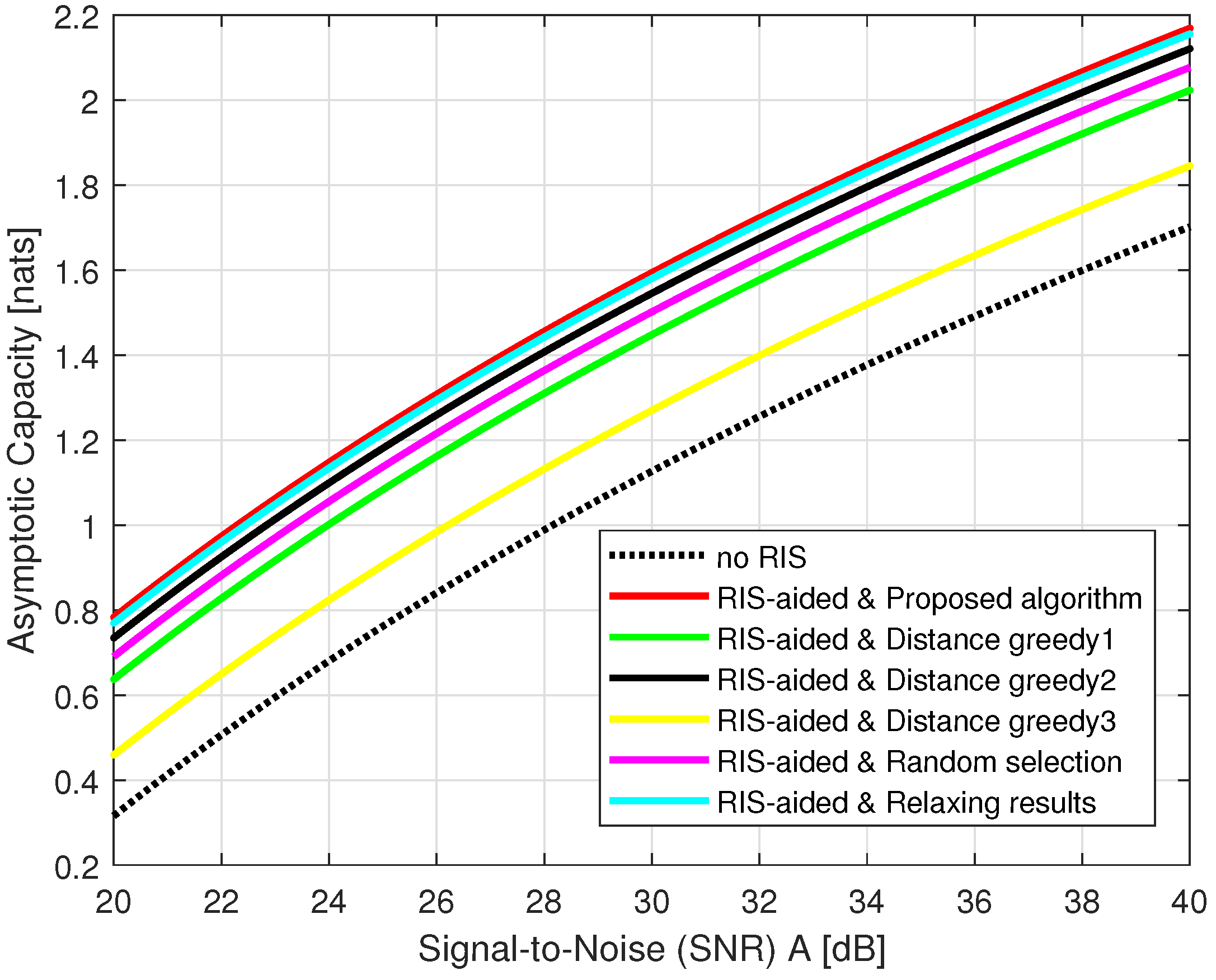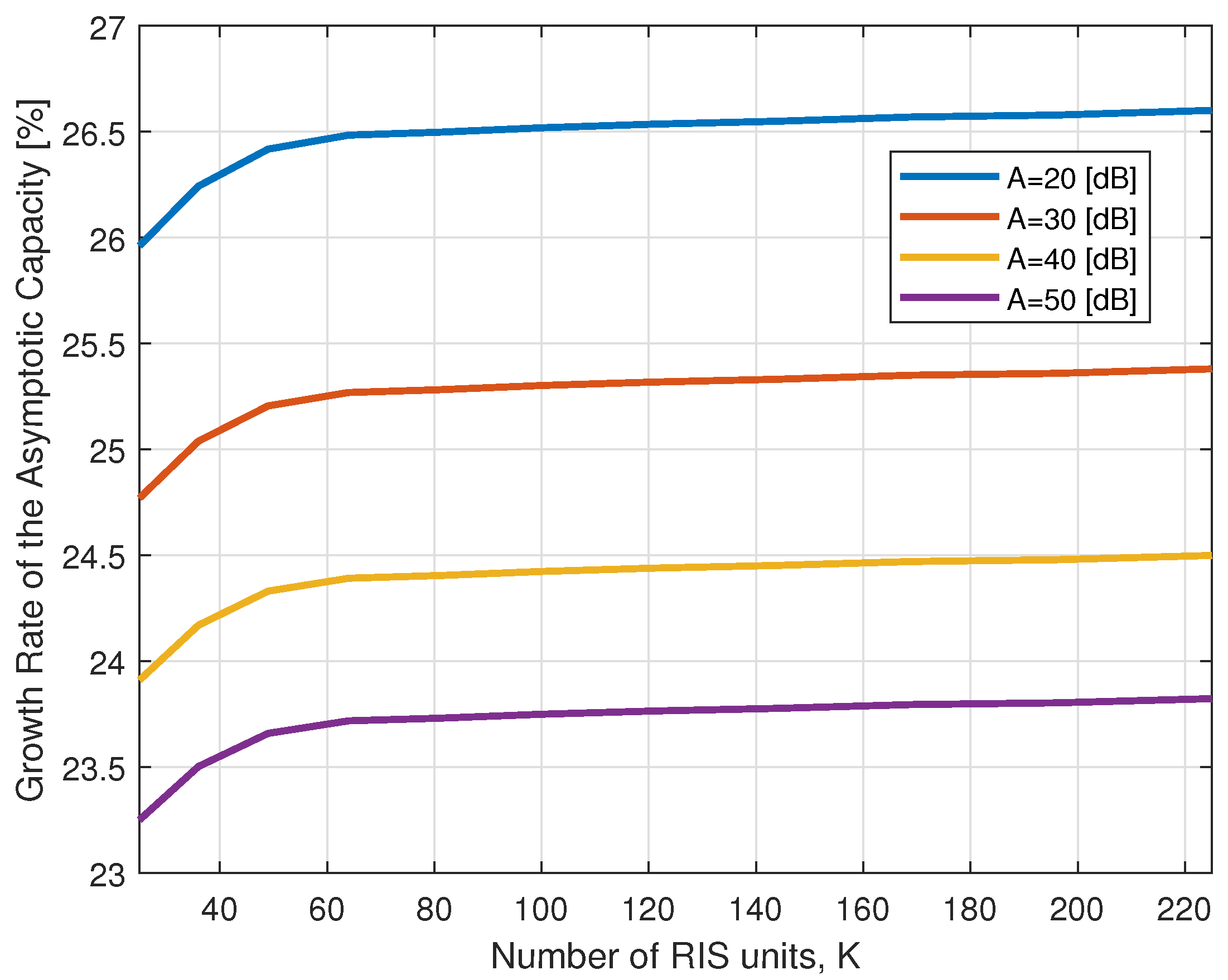Configuring Reconfigurable Intelligent Surface for Parallel MIMO Visible Light Communications with Asymptotic Capacity Maximization
Abstract
1. Introduction
2. Channel Model
2.1. The Channel Gain of LoS Links
2.2. The Channel Gain of NLoS Links
2.3. The Channel Matrix of the RIS-Aided Parallel MIMO VLC System
3. Problem Formulation and Proposed Solution
3.1. Problem Formulation
3.2. The Relaxed Result for Asymptotic Capacity Maximization
3.3. The RPSO Algorithm
| Algorithm 1 The RPSO algorithm for Asymptotic Capacity Maximization |
Input: Size of the particle swarm m; Maximum number of iterations T; Output: The historically optimal position of the entire particle swarm ; The historically optimal fitness of the particle swarm;
|
3.4. Complexity Analysis
4. Simulation Results
4.1. Convergence Analysis
4.2. Influence of Assignment Schemes on Asymptotic Capacity
4.3. Influence of the Number of RIS Units on Asymptotic Capacity
5. Conclusions
Author Contributions
Funding
Institutional Review Board Statement
Informed Consent Statement
Data Availability Statement
Conflicts of Interest
References
- Obeed, M.; Salhab, A.M.; Alouini, M.S.; Zummo, S.A. On optimizing VLC networks for downlink multi-user transmission: A survey. IEEE Commun. Surv. Tutor. 2019, 21, 2947–2976. [Google Scholar] [CrossRef]
- Karunatilaka, D.; Zafar, F.; Kalavally, V.; Parthiban, R. LED based indoor visible light communications: State of the art. IEEE Commun. Surv. Tutor. 2015, 17, 1649–1678. [Google Scholar] [CrossRef]
- Fath, T.; Haas, H. Performance comparison of MIMO techniques for optical wireless communications in indoor environments. IEEE Trans. Commun. 2012, 61, 733–742. [Google Scholar] [CrossRef]
- Ciaramella, E.; Arimoto, Y.; Contestabile, G.; Presi, M.; D’Errico, A.; Guarino, V.; Matsumoto, M. 1.28 Terabit/s (32x40 Gbit/s) WDM transmission system for free space optical communications. IEEE J. Sel. Areas Commun. 2009, 27, 1639–1645. [Google Scholar] [CrossRef]
- Monteiro, E.; Hranilovic, S. Design and implementation of color-shift keying for visible light communications. J. Lightwave Technol. 2014, 32, 2053–2060. [Google Scholar] [CrossRef]
- Gao, Q.; Wang, R.; Xu, Z.; Hua, Y. DC-informative joint color-frequency modulation for visible light communications. J. Lightwave Technol. 2015, 33, 2181–2188. [Google Scholar] [CrossRef]
- Abdelhady, A.M.; Amin, O.; Chaaban, A.; Alouini, M.S. Downlink resource allocation for multichannel TDMA visible light communications. In Proceedings of the 2016 IEEE Global Conference on Signal and Information Processing (GlobalSIP), Washington, DC, USA, 7–9 December 2016; pp. 1–5. [Google Scholar]
- Chaaban, A.; Rezki, Z.; Alouini, M.S. Fundamental limits of parallel optical wireless channels: Capacity results and outage formulation. IEEE Trans. Commun. 2016, 65, 296–311. [Google Scholar] [CrossRef]
- ElMossallamy, M.A.; Zhang, H.; Song, L.; Seddik, K.G.; Han, Z.; Li, G.Y. Reconfigurable intelligent surfaces for wireless communications: Principles, challenges, and opportunities. IEEE Trans. Cogn. Commun. Netw. 2020, 6, 990–1002. [Google Scholar] [CrossRef]
- Basar, E.; Di Renzo, M.; De Rosny, J.; Debbah, M.; Alouini, M.S.; Zhang, R. Wireless communications through reconfigurable intelligent surfaces. IEEE Access 2019, 7, 116753–116773. [Google Scholar] [CrossRef]
- Di Renzo, M.; Zappone, A.; Debbah, M.; Alouini, M.S.; Yuen, C.; De Rosny, J.; Tretyakov, S. Smart radio environments empowered by reconfigurable intelligent surfaces: How it works, state of research, and the road ahead. IEEE J. Sel. Areas Commun. 2020, 38, 2450–2525. [Google Scholar] [CrossRef]
- Guo, H.; Liang, Y.C.; Chen, J.; Larsson, E.G. Weighted sum-rate maximization for reconfigurable intelligent surface aided wireless networks. IEEE Trans. Wirel. Commun. 2020, 19, 3064–3076. [Google Scholar] [CrossRef]
- Aboagye, S.; Ngatched, T.M.; Dobre, O.A.; Ndjiongue, A.R. Intelligent reflecting surface-aided indoor visible light communication systems. IEEE Commun. Lett. 2021, 25, 3913–3917. [Google Scholar] [CrossRef]
- Cao, B.; Chen, M.; Yang, Z.; Zhang, M.; Zhao, J.; Chen, M. Reflecting the light: Energy efficient visible light communication with reconfigurable intelligent surface. In Proceedings of the 2020 IEEE 92nd Vehicular Technology Conference (VTC2020-Fall), Victoria, BC, Canada, 18 November–16 December 2020; pp. 1–5. [Google Scholar]
- Sun, S.; Yang, F.; Song, J. Sum rate maximization for intelligent reflecting surface-aided visible light communications. IEEE Commun. Lett. 2021, 25, 3619–3623. [Google Scholar] [CrossRef]
- Sun, S.; Yang, F.; Song, J.; Han, Z. Joint resource management for intelligent reflecting surface–aided visible light communications. IEEE Trans. Wirel. Commun. 2022, 21, 6508–6522. [Google Scholar] [CrossRef]
- Qian, L.; Chi, X.; Zhao, L.; Chaaban, A. Secure visible light communications via intelligent reflecting surfaces. In Proceedings of the ICC 2021-IEEE International Conference on Communications, Montreal, QC, Canada, 14–23 June 2021; pp. 1–6. [Google Scholar]
- Sun, S.; Yang, F.; Song, J.; Han, Z. Optimization on Multi-User Physical Layer Security of Intelligent Reflecting Surface-Aided VLC. arXiv 2022, arXiv:2201.00705. [Google Scholar]
- Wu, Q.; Zhang, J.; Guo, J. Capacity Maximization for Reconfigurable Intelligent Surface-Aided MISO Visible Light Communications. Photonics 2022, 9, 487. [Google Scholar] [CrossRef]
- Sun, S.; Yang, F.; Song, J.; Zhang, R. Intelligent Reflecting Surface for MIMO VLC: Joint Design of Surface Configuration and Transceiver Signal Processing. arXiv 2022, arXiv:2206.14465. [Google Scholar]
- Wu, Q.; Zhang, J.; Guo, J.N. Position Design for Reconfigurable Intelligent-Surface-Aided Indoor Visible Light Communication Systems. Electronics 2022, 11, 3076. [Google Scholar] [CrossRef]
- Abdelhady, A.M.; Salem, A.K.S.; Amin, O.; Shihada, B.; Alouini, M.S. Visible light communications via intelligent reflecting surfaces: Metasurfaces vs mirror arrays. IEEE Open J. Commun. Soc. 2020, 2, 1–20. [Google Scholar] [CrossRef]
- Komine, T.; Nakagawa, M. Fundamental analysis for visible-light communication system using LED lights. IEEE Trans. Consum. Electron. 2004, 50, 100–107. [Google Scholar] [CrossRef]
- Lee, K.; Park, H.; Barry, J.R. Indoor channel characteristics for visible light communications. IEEE Commun. Lett. 2011, 15, 217–219. [Google Scholar] [CrossRef]
- Tang, T.; Shang, T.; Li, Q. Impact of multiple shadows on visible light communication channel. IEEE Commun. Lett. 2020, 25, 513–517. [Google Scholar] [CrossRef]
- Bubeck, S. Convex optimization: Algorithms and complexity. Found. Trends Mach. Learn. 2015, 8, 231–357. [Google Scholar] [CrossRef]
- Shi, Y.; Eberhart, R.C. Empirical study of particle swarm optimization. In Proceedings of the 1999 Congress on Evolutionary Computation-CEC99 (Cat. No. 99TH8406), Washington, DC, USA, 6–9 July 1999; Volume 3, pp. 1945–1950. [Google Scholar]




| Parameter | Value |
|---|---|
| LED half-power semiangle | |
| Physical area of the PD | 1 |
| Optical concentrator gain | 1 |
| Field of view | |
| Refractive index a | 1 |
| Location of the center point of RIS | |
| Location of the LED 1 | |
| Location of the LED 2 | |
| Area of the RIS unit | 10 cm × 10 cm |
Disclaimer/Publisher’s Note: The statements, opinions and data contained in all publications are solely those of the individual author(s) and contributor(s) and not of MDPI and/or the editor(s). MDPI and/or the editor(s) disclaim responsibility for any injury to people or property resulting from any ideas, methods, instructions or products referred to in the content. |
© 2022 by the authors. Licensee MDPI, Basel, Switzerland. This article is an open access article distributed under the terms and conditions of the Creative Commons Attribution (CC BY) license (https://creativecommons.org/licenses/by/4.0/).
Share and Cite
Wu, Q.; Zhang, J.; Zhang, Y.; Xin, G.; Guo, J. Configuring Reconfigurable Intelligent Surface for Parallel MIMO Visible Light Communications with Asymptotic Capacity Maximization. Appl. Sci. 2023, 13, 563. https://doi.org/10.3390/app13010563
Wu Q, Zhang J, Zhang Y, Xin G, Guo J. Configuring Reconfigurable Intelligent Surface for Parallel MIMO Visible Light Communications with Asymptotic Capacity Maximization. Applied Sciences. 2023; 13(1):563. https://doi.org/10.3390/app13010563
Chicago/Turabian StyleWu, Qi, Jian Zhang, Yanyu Zhang, Gang Xin, and Jianing Guo. 2023. "Configuring Reconfigurable Intelligent Surface for Parallel MIMO Visible Light Communications with Asymptotic Capacity Maximization" Applied Sciences 13, no. 1: 563. https://doi.org/10.3390/app13010563
APA StyleWu, Q., Zhang, J., Zhang, Y., Xin, G., & Guo, J. (2023). Configuring Reconfigurable Intelligent Surface for Parallel MIMO Visible Light Communications with Asymptotic Capacity Maximization. Applied Sciences, 13(1), 563. https://doi.org/10.3390/app13010563






